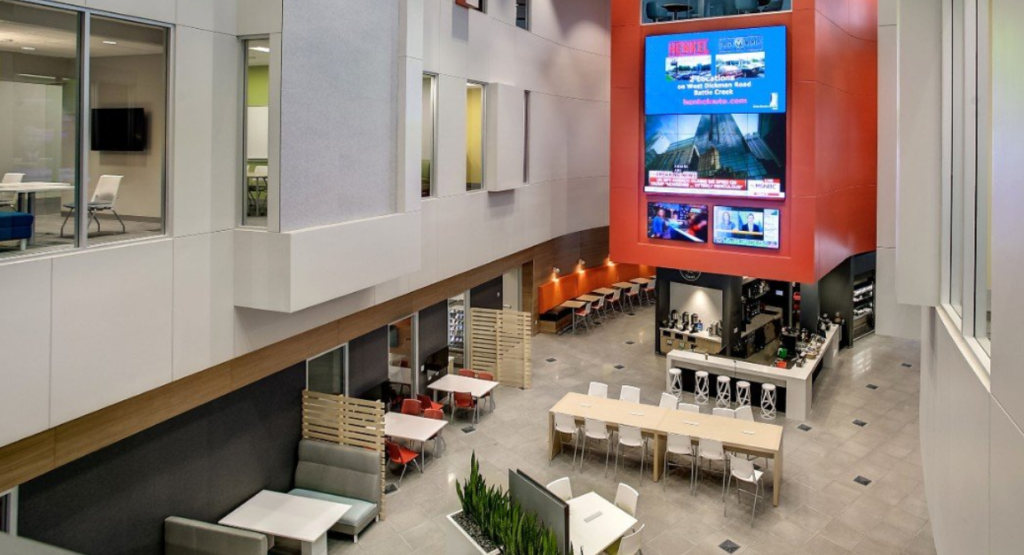A Glimpse at How to Use Space to Attract and Inspire University Students.
The competitive landscape for procuring university students is fiercer than ever. In the spring of 2021, higher education enrollment dropped 3.5%, a figure that’s seven times greater than the previous year’s decline.
To attract the next generation of scholars, forward-thinking academic institutions are creating spaces that put students’ needs first. At Haworth, we have the privilege of working with universities—and we’ve observed 7 design elements schools are using to charm and inspire prospective and returning students.
1. Welcome with a “Wow”
The notion that you never get a second chance to make a first impression holds true for university spaces. For students touring a half-dozen or more campuses in-person or by video, distinctively designed spaces are far more impressive and memorable. The most effective university space designs create a warm, welcoming atmosphere with a “wow” factor.
Case in point, at the College of Aviation at Western Michigan University (WMU), located at the Battle Creek Executive Airport in Michigan, an outdoor firepit welcomes students before they even set foot in the building. Once inside, prospective students and their parents experience a hub of activity.
An easy-to-locate reception area is staffed by aviation student ambassadors who greet prospective visitors upon entry into the building. Semi-private spaces provide areas for prospective students and their parents to talk with current students, staff, and faculty. In benching spaces, current students settle in to study, work, and socialize. Expansive windows give visitors a view of airport operations while large aviation graphics supported by the school’s colors help reinforce the institution’s values and ideals. Altogether, the space creates a feeling of excitement. For many, this leads prospective students to say, “I want to go to school here,”—exactly the thought that a welcoming university space should inspire.
2. Inspire Collaboration
Learning is enhanced by conversations that inform, challenge, and build on ideas. Some of the most valuable experiences for college students are their interactions with peers, professors, and staff that lead to the development of soft skills required of them in the workplace. Academic spaces serve students best when they have access to places to engage with one another.
At Clemson University, the mission of The Watt Family Innovation Center is to create an environment where collaboration among students, faculty, and leaders from industry and government agencies can come together to generate ideas and solve complex problems. One design element employed to achieve their mission is a space that is often overlooked: corridors.
The corridors at the Watt Family Innovation Center were designed to be wider than usual—with walls that include technology. Supported by building-wide Wi-Fi, students have ample access to audio-visual components, outlets, and other accessories to do work from their laptops in the lounge areas. The space fosters interaction as students, faculty, and industry partners seek to take ideas from concept to the marketplace.
3. Work Anywhere
Students expect to be able to do their course work nearly anywhere. University spaces equipped with mobile technology give students flexibility whenever they need it. The Hub at the Donald W. Maine College of Business at Davenport University features exceptional social space design.
Within an open environment—featuring areas to socialize and collaborate—is a coffee bar with tall tables that provide power and connectivity for informal work sessions. Surrounding the atrium are three floors of enclaves, touchdown points, and meeting areas where students can have drop-in meetings. The Hub, with its cloud-based platform for visual collaboration, makes it easy for individuals and teams to create, interact, and share content in real-time on different devices.
